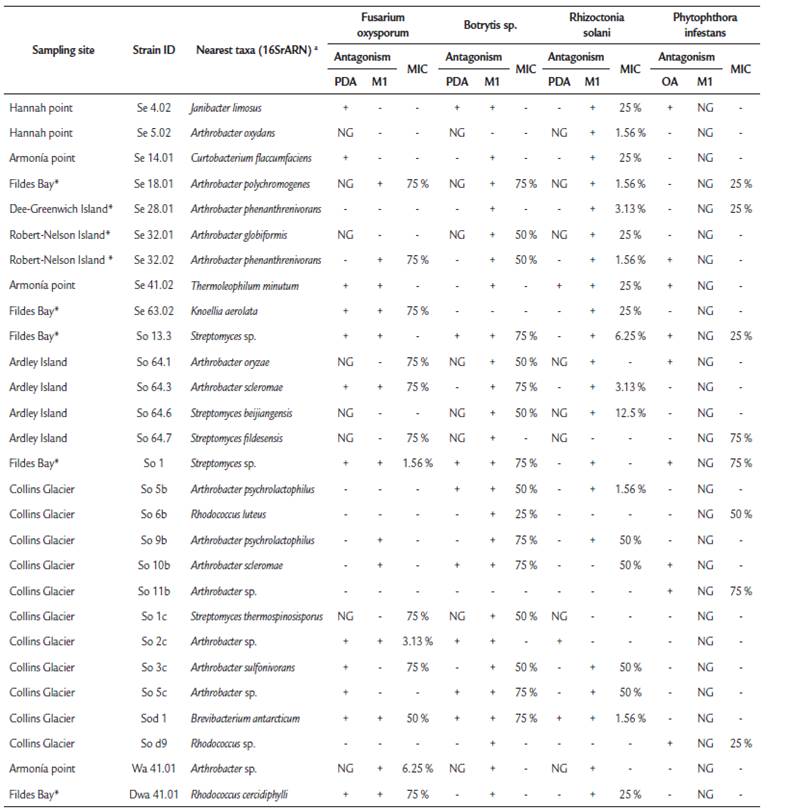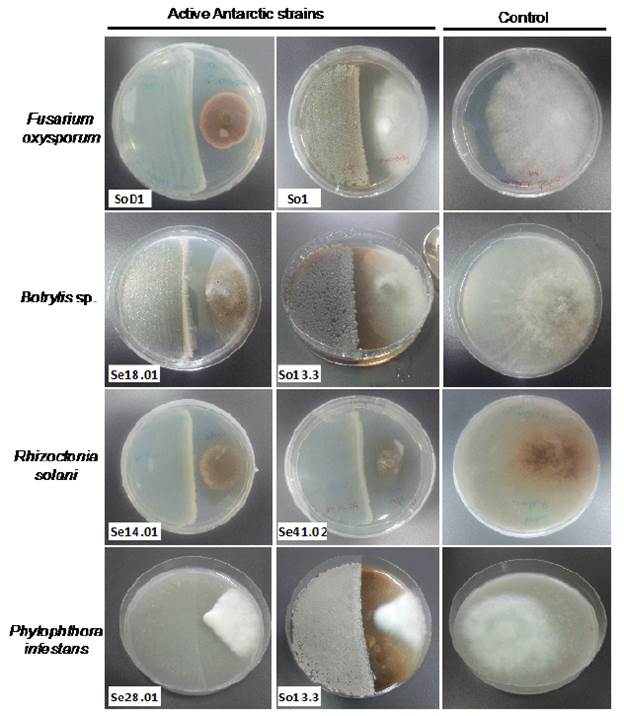Antarctica is an isolated ice-bound continent; only 0.34 % of its area is ice-free with terrestrial ecosystems such as exposed nunataks and cliffs (Convey et al., 2009). Biodiversity is simple compared with other regions of the Earth, due to the severe climatic conditions and the scarcity of suitable habitats. Higher taxonomic groups are not represented in this environment; however in terms of biomass and diversity, microorganisms dominate both (Convey et al., 2009). The Actinobacteria phylum has been reported as one of the more abundant microbial groups in different Antarctic regions (Cary et al., 2010; Pearce et al., 2012). This phylum is recognized as a producer of a wide variety of secondary metabolites with different activities including herbicides, antifungals, antitumor or immunosuppressant compounds, and anthelmintic agents (Manivasagan et al., 2014).
Bacteria inhabiting Antarctica have adopted peculiar survival strategies to achieve competitive advantages (Núñez-Montero and Barrientos, 2018). Particularly, antagonistic activity may contribute to the adaptation of Antarctic bacteria to permanently low temperatures by reducing the presence of competitive microorganisms (Lo Giudice et al., 2007). Therefore, we hypothesized that our collection of Antarctic psychrophilic Actinobacteria might represent an unexplored source of antifungal compounds for the biocontrol of phytopathogenic fungi, helping to cover an essential need in agriculture.
Plant-fungal pathogens cause most of the diseases occurring in agricultural and horticultural industries, leading to annual economic losses that exceed 200 billion US dollars (Shuping and Eloff, 2017). Fungi species such as Phytophthora infestans, Fusarium oxysporum, Botrytis sp., and Rhizoctonia solani are probably some of the most essential plant pathogens currently described. P. infestans is a foliar pathogen and causes severe losses to potato and tomato crops worldwide, while some pathogenic strains of F. oxysporum are responsible for wilt in various plant species (Son et al., 2008). Botrytis sp. is the causal agent of gray mold disease in a broad range of dicotyledonous plants, with a large impact on wine grapes (Plesken et al., 2015). Finally, R. solani is known as the cause of rice sheath blight, black scurf on potatoes, bare patch on cereals, and root on soybean, among many other diseases (Wibberg et al., 2016).
It is extremely important to find new organic and environmentally friendly sources to help control plant pathogenic fungi, considering that the indiscriminate and excessive use of fungicides owing to reduced efficacy of this products has led to environmental pollution and high residual toxicity (Son et al., 2008). This study aimed to determine the antifungal effect of actinobacteria strains isolated from the Antarctic against phytopathogenic fungi of agricultural interest.
A total of 28 Antarctic Actinobacteria strains previously isolated from soil, marine sediment and seawater were used (Lamilla et al., 2017) to evaluate the antagonistic effect against four phytopathogenic fungi: Fusarium oxysporum, Rhizoctonia solani, Botrytis sp., and Phytophthora infestans, kindly facilitated by the INIA-Chile collection (National Institute for Agricultural Research, Chile). To this aim, an in vitro antagonism assay by dual culture method was used to select the strains with potential for biocontrol, as previously described in similar works (Quecine et al., 2008; Costa et al., 2013; Law et al., 2017). Briefly, fungi inocula were cultivated in potato dextrose agar (PDA, Difco), except for P. infestans performed in V8 agar (CaCO3 3 g/L, agar 20 g/L, 16 % commercial V8 Campbell's juice) or OA (Oatmeal Agar: oatmeal 60 g/L, agar 15 g/L, pH 7.2).
Actinobacteria inoculum was grown in M1 broth (peptone 2.0 g/L, yeast extract 4.0 g/L, starch 10.0 g/L; agar 18.0 g/L, pH 7.0) at 150 rpm, 15 °C for five days. Bacterial suspensions equivalent to 0.5 McFarland were prepared for each Actinobacteria strain and cultivated in half of PDA, M1 or OA plates, which were incubated at 15 °C for eight days. Agar discs from each fungus were placed in the middle of the remaining agar plate (approximately 2 cm from the actinobacteria culture). The co-cultures were incubated at 20 °C, and inhibitory zones were evaluated after 48 h. Supernatants from active actinobacterial strains (30 ml from M1 cultures) were used to determine the Minimum Inhibitory Concentration (MIC) at 75, 50, 25, 12.5, 6.25, 3.3 and 1.56 % for each supernatant following the Clinical and Laboratory Standards Institute (Weinstein et al., 2012) recommended protocol in microdilution plate. Negative controls were performed using media without bacteria. All experiments were performed in triplicate.
Our results showed a high rate of antifungal activity among our Antarctic actinobacteria isolates (Table 1, Fig.1). All the strains showed antifungal activity for at least one of the fungi studied, most of them belonging to genus Arthrobacter (53 %), Streptomyces (17 %) and Rhodococcus (3.5 %). These genera are recognized for its capacity to produce antibiotic molecules: Streptomyces is a genus characterized by the ability to produce secondary metabolites, representing 70-80 % of the antibiotics produced by Actinobacteria (Jackson et al., 2018; Núñez-Montero et al., 2019); antifungal tetrapeptides and antimycobacterial molecules have been characterized from Rhodococcus sp. (Chiba et al., 1999; Iwatsuki et al., 2007); and Arthrobacter is a common genus ofActinobacteria present in soil, capable ofproducing antibiotics such as arthrobacillin type A, B and C (Wietz et al., 2010). Results showed that particularly strain Se18.01 (Arthrobacter polychromogenes) was capable of inhibiting the growth of all tested fungi; therefore, these bacteria could be secreting one or multiple bioactive metabolites with activity against phytopathogenic fungi, which have a pronounced and broad antifungal effect.
Table 1 Antagonistic effect and MIC determination of 28 actinobacteria strains isolated from Antarctic against four phytopathogenic fungi.

*Area with human presence
a Based on (Lamilla et al., 2017)
+: inhibition of mycelial growth of the fungus is observed
-: No inhibition of mycelial growth of the fungus is observed
NG: No suitable growth of the actinobacteria strain or fungi in the media tested
PDA: Potato Dextrose Agar M1: M1 Agar
OA: Oatmeal Agar
MIC: Minimal Inhibitory Concentration

Figure 1 Different actinobacteria Antarctic strains inhibiting the growth of phytopathogenic fungi on agar plate antagonism assay.
MIC determination showed that 13 of the strains (48 %) were able to inhibit the growth of F. oxysporum; these strains corresponded to Streptomyces sp. (So1) and Arthrobacter sp. (So2c and Dwa41.01), which inhibited at low concentrations (1.56 %; 3.13 %; and 6.25 %, respectively). Coincidently, other reports have shown the antifungal activity of Streptomyces sp. and Arthrobacter sp. against Fusarium sp. (Legrand et al., 2017; Rashad et al., 2017), however, there are no reports of cold-adapted members of these genera with activity against F. oxysporum.
On the other hand, Rhodococcus sp. (So6b) showed the lowest MIC (25 %) against Botrytis sp. among other 16 active strains with MIC values between 50 % and 75 %. To the best of our knowledge, this is the first report addressing the antifungal activity of an Antarctic Rhodococcus strain against Botrytis sp. Other authors have reported the antimicrobial activity from a marine Rhodococcus strain (Yellamanda et al., 2016), highlighting the potential of this genus for exploration of biological activities, and particularly, antifungal compounds. Similarly, four Arthrobacter strains (Arthrobacter oxydans Se5.02, Arthrobacter polychromogenes Se18.01 , Arthrobacter phenanthrenivorans Se32.02, Arthrobacter psychrolactophilus So5b) were able to inhibit the growth of Rhizoctonia solani at the lowest concentration tested (1.56 %), antagonistic relationships that have not been reported to date. Additionally, Phytophthora infestans was inhibited by eight out of 28 strains (26 %) with a lowest MIC of 25 % for Arthrobacter polychromogenes (Se18.01), Arthrobacter phenanthrenivorans (Se28.01), Streptomyces sp.(So13.3), and Rhodococcus sp. (Sod9), being the first description of antagonistic activity of these strains against P. infestans. The new antifungal potential activities described here suggest that Antarctic -and other extreme environments- could provide a new source for the discovery of active molecules due to the differential evolutionary attributes of its microbial life.
Antagonism on agar plates also showed that most of the actinobacteria strains change their activity dependently of the culture media composition. As previously reported, this could be explained because different culture conditions will activate distinct biosynthetic pathways for secondary metabolites production, since actinobacteria can have multiple silent biosynthetic gene clusters, which can be expressed under specific conditions (Rosen and Seyedsayamdost, 2017). Therefore, the nutritional differences between the tested culture media (M1, PDA or OA) allowed or suppressed the production of the antifungal bioactive metabolites. Consequently, in a further analysis it should be possible to design an optimized culture condition increasing the efficiency of Antarctic actinobacteria activity and production of antifungal compounds.
Antibiotic molecules by psychrophiles and psychrotolerant organisms has been poorly studied in comparison with mesophilic organisms (O'Brien et al., 2004); particularly, actinobacteria have been proposed as unexplored microorganisms for biocontrol in vegetable crops, nonetheless anti-phytopathogenic activity derived from Antarctic actinobacteria have been previously reported only for some bacterial plant pathogens (i.e. Xhanthomonas sp. and Erwinia sp.) (Núñez-Montero and Barrientos, 2018). Some other works have described anti-phytopathogenic fungi effects and biocontrol potential from Antarctic yeast strains (Vero et al., 2013; Sangorrín et al., 2014) and fungus (Fenice and Gooday, 2006), and cold-adapted chitinolytic microorganisms have been described as an attractive source for potential biocontrol of phytopathogens in cold environments and the biocontrol of microbial spoilage of refrigerated food (Park et al., 2009; Ramli et al., 2011). Our work provides valuable data on Antarctic actinobacteria strains with the capacity to produce antifungal compounds against phytopathogenic fungi and has a real potential to become a fungicide or antifungal source for biocontrol in multiple crops. Also, we should note the importance of performing the chemical analyzes to determine the novelty of the metabolites being produced by these Antarctic strains and field trials for the promising actinobacterial strains will be undertaken to validate their possible role as biocontrol agents. It is noteworthy that cold-adapted actinobacteria might represent an interest biocontrol source, protecting crops with higher efficiency even at low temperatures during winter and in temperate climate zones.














